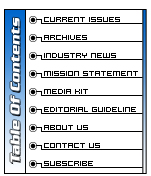|
GPS/GIS Mapping Zooms in on Satellite Imagery
By Suzanne Richardson Zoom in on the fine detail. Zoom out on the broad span. With the convergence of three well-established technologies, satellite imagery, Global Positioning Systems (GPS), and geographic information systems (GIS), remote sensing is quickly moving from an abstract art to high realism. GPS/GIS mapping now takes satellite imagery directly into the field, greatly extending its value and uses for applications as diverse as environmental monitoring, precision farming, and measuring urban sprawl. Scientists who rely on raw satellite imagery to provide broad brush strokes of planetary phenomena can now bring that same imagery down to earth to create detailed and highly accurate base map products.
Complete GPS/GIS field mapping systems, such as the patented GeoLink Mapping System from GeoResearch Inc., feature full screen raster or vector background map capability that can accurately register background maps through known control points. Satellite imagery, such as those from SPOT Image Corp., can be registered and brought into the field as a background coverage. Other vector layers of information, such as a visual trace of the user's path or multiple GIS files may be overlaid on the satellite image for further efficiency in the field.
GPS/GIS mapping technology uses GPS data to continuously pinpoint position and create an accurate digital map of the user's path. Using small, lightweight, pen-based computers, field mapping personnel can quickly enter multiple layers of attribute data describing each point, while watching their GIS maps evolve on the screen. GIS translation functions within GeoLink instantly create spatial information layers for GIS databases. Advanced GPS/GIS systems may also offer GPS integration with other forms of data, such as data from electronic sensors (temperature, depth, radiation, etc.) to automatically map almost any phenomena. Ground-based digital or video images may also be associated with position to create a visual reference library of the features mapped.
The ability to use satellite imagery for field investigations promises to dramatically enhance the production of maps in many areas of the world, where map sources tend to be outdated, inaccurate, or completely nonexistent. Field mapping personnel now have the advantage of an up-to-date map reference on which to record detailed, geographically correct, feature information. Once in the field, the satellite image provides several invaluable functions. First it is a visual reference against which GPS-collected data is displayed; second it is a field guide indicating areas for investigation; and third, and perhaps most importantly, it is a backdrop or geographic glue for an entire GIS database.
GPS/GIS mapping with satellite imagery has been used in Moscow, Russia. Extensive GPS/GIS field data describing bridges and infrastructure were collected for business analysis and development. When it came time to display the information, no local map sources were available. Up-to-date satellite imagery filled the bill very nicely.
GeoResearch Inc. is currently participating in a major study of environmental influences on the shellfish production and aquaculture in the Laguna di Venezia, Italy, using the GeoLink GPS/GIS with satellite imagery. SPOT satellite images used for analysis of water temperature, phytoplankton concentrations, eutrophication, and potential soil erosion are being combined with detailed GeoLink GPS/GIS data collected in the sprawling estuary. SPOT imagery combined with GeoLink is providing an excellent tool for investigating the oblique waters of the estuary's ecosystem. The combined use of the two technologies allows rapid assessment of up-to-the-minute aquatic and environmental conditions.
The advantages of satellite imagery - its currency, its impartial coverage of the entire globe and its affordability - are making it a GPS/GIS background map of choice for large parts of the world. When combined with the ground truthed specificity of GPS/GIS field mapping, it is promising to open a whole new world of applications for satellite imagery. About the Author:
Suzanne Richardson is a writer and communications specialist at GeoResearch Inc. She has authored numerous articles on GPS/GIS applications and is consulted frequently on the integration and many uses of GPS/GIS technology. She may be reached at 301-320-0911.
Back
|

